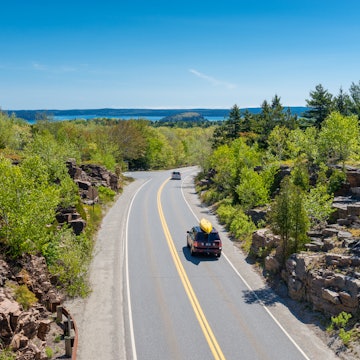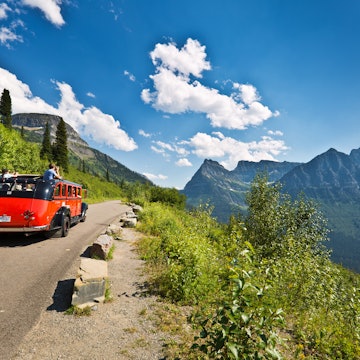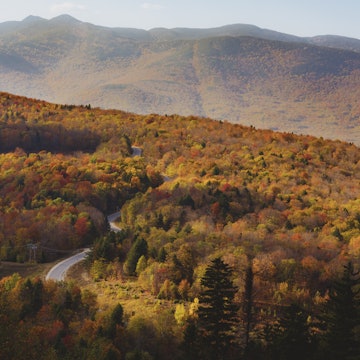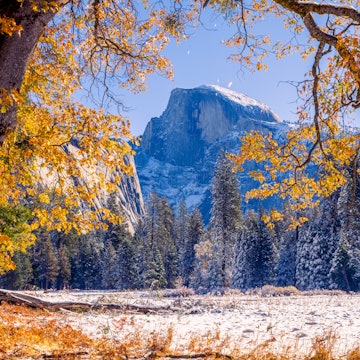

Acadia National Park. Kurdistan/Shutterstock
Waves crash against a rocky shore beneath a picturesque lighthouse as seabirds soar and dive overhead. Ancient mountains rise above the rugged, indented coastline, rounded by the ages and covered with deep forests, opening up here and there to reveal a tranquil pond or moose grazing in a wildflower meadow. At higher elevations, the vegetation becomes less dense, exposing patches of centuries-old granite and panoramic views.
This magical meeting place of land and sea is Acadia National Park, Maine's crown jewel and one of the most scenic coastal spots along the eastern seaboard of the United States. The park covers nearly 50,000 acres in four sections, each with its own distinct character. The heart of Acadia is Mount Desert Island, which is shaped roughly like a lobster claw and connected to the mainland by a two-lane causeway south of Ellsworth. Many visitors never get beyond the eastern side of the island, where the best-known places to see are located, but the west side – known as the Quiet Side – is equally scenic and, as its nickname suggests, less crowded. Although nature is Acadia’s star attraction, there are also interesting opportunities to explore the area’s cultural history, from the heritage and living traditions of the indigenous Wabanaki people to the legacies of later settlers who made their living through farming, fishing, lobstering and other trades.
South of Mount Desert Island lie the Cranberry Isles, with a few historic sites managed by the National Park Service that can be visited on boat tours. Even further out to sea, off to the southwest, lies Isle au Haut, half of which is part of the national park and has very limited services. The only mainland part of Acadia lies east of Mount Desert Island at the southern tip of the quieter but equally stunning Schoodic Peninsula, accessible by road or passenger ferry from Bar Harbor, Mount Desert Island’s principal town.

When should I go to Acadia National Park?
If you want full access to Acadia’s attractions, visit between May and mid-October, while the off season is when you'll find solitude. High season is summer, June through August. September typically brings beautiful, comfortable weather, with glorious foliage as autumn arrives. Fall colors generally peak in mid-October, which is also when the first frost tends to arrive – as do busloads of leaf peepers. If you’re visiting during the summer with its long hours of daylight, start your days early and get where you're going by 9am (no later than 10am) to beat the crowds.
Although Acadia is open year-round, many roads and attractions shut down during the colder months. Snow often falls from November until as late as April, with temperatures dropping well below freezing in winter. Services are minimal during the off-season, and the Park Loop Rd (and almost all other paved roads) are closed from December 1 to April 14. However, the park’s 45 miles of carriage roads, which are open only to motor-free traffic, are accessible year-round and are popular with cross-country skiers and snowshoers in winter.
How much time should I spend in Acadia National Park?
With a full day in Acadia, drive the Park Loop Rd, stopping for walks and views along the way, and also drive up Cadillac Mountain, perhaps in time for sunrise or sunset. (Be sure to make a reservation.) At least another day is necessary if you want to explore Mount Desert Island more fully, venturing over to the quieter west side of the island or going for a longer day hike or bike ride.
With three or four days, you’ll have time to explore Mount Desert Island in depth, as well as the Schoodic Peninsula. You may even squeeze in a boat trip to the remote Isle au Haut or the historic Cranberry Isles. If you’re an avid hiker or cyclist, you could easily spend a week exploring Acadia without running out of scenic trails and roads. The same goes for experienced kayakers, when it comes to paddling the park’s picturesque coves and inlets.
Is it easy to get in and around Acadia National Park?
Acadia National Park is located Downeast, the region of Maine’s coast that’s closer to Canada than to other US states. It's about a 3-hour drive by car from Portland, the state’s largest city, and approximately 4½ to 5 hours by car from Boston, Massachusetts. There are direct flights from Boston’s Logan Airport to Hancock County-Bar Harbor Airport, 10 miles from Acadia, as well as flights from numerous other US destinations to Bangor International Airport, about an hour away.
Once in Acadia, it’s possible to get around without a car using the free Island Explorer buses, which travel several different routes throughout the park’s Mount Desert Island section (except for Cadillac Mountain Rd), as well as on the Schoodic Peninsula, which is connected to Bar Harbor by passenger ferry. (Note that even though the buses are free, visitors must still have a valid park entrance pass.) For those who prefer two wheels, bicycle rentals, including e-bikes, are available in the park and in Bar Harbor, as well as in Winter Harbor on the Schoodic Peninsula. The most remote part of Acadia, Isle au Haut, is accessible only by passenger ferry. Baker Island and the Islesford Historical Museum on Little Cranberry Island, both administered by the National Park Service, can be visited on boat tours.
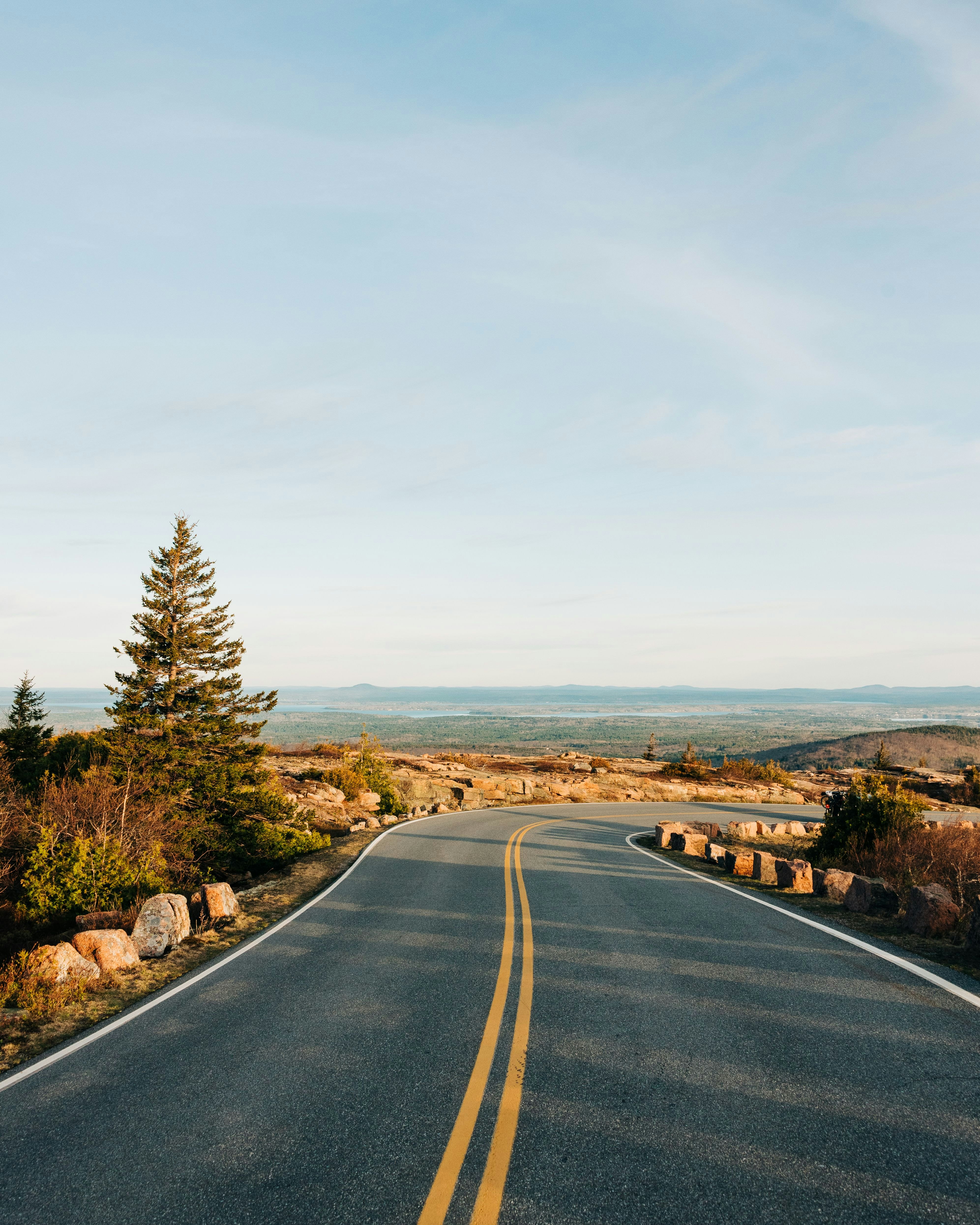
Top things to do in Acadia National Park
Explore the sights along the Park Loop Road
The 27-mile loop road through Mount Desert Island’s southeastern portion is the heart of Acadia National Park and can be traveled by car, bicycle or the free Island Explorer bus. The route starts at Hulls Cove Visitor Center and makes a clockwise circuit with mostly one-way traffic. At Sieur de Monts Spring, wander through the Wild Gardens of Acadia, featuring microcosms of the 12 different native habitat types found in the park. Highlights along the south coast are the lovely (if unimaginatively named) Sand Beach and Thunder Hole, a narrow natural channel carved out of a rocky shore where rushing waves, under the right conditions, splash high into the air with a thunderous roar.
Further on are more scenic stretches of coastline, after which the Park Loop Rd turns inland to a pair of lovely lakes that can be circumnavigated on foot: Jordan Pond and Eagle Lake. Other recommended hikes in the Jordan Pond area include trails up Sargent Mountain and Pemetic Mountain, both of which reward the effort with stunning views. The Park Loop Rd is very popular, so start early in the morning or late in the afternoon during peak season to avoid crowds.
Catch the sunrise (or sunset) from Cadillac Mountain
At 1530ft, Cadillac Mountain is Acadia’s highest point, making its rocky summit one of the park’s most popular and panoramic viewpoints. Cadillac is famous as the first place in the US to see the sunrise, a claim that more accurately only applies from October 7 to March 6, though this technicality doesn’t stop visitors from flocking to the summit to catch the sun’s first rays year round. To mitigate traffic on the three-mile road to the summit, the National Park Service has implemented a reservation system, so if you’re aiming to be on top at dawn, plan ahead and be ready to snag a time slot in the online booking portal as soon as reservations open for your date.
Although sunrise is the biggest draw, Cadillac’s 360-degree views make it an equally good spot to watch the sunset, so if you miss out on a sunrise booking or simply aren’t a morning person, being on the summit to catch the sun’s last rays is an excellent alternative. You’ll still need a reservation to drive up the mountain, but since there’s no time limit for how long you can stay up top, grab an earlier slot and have time for a nice hike while you wait for daylight to fade. Alternatively, you can hike up and down Cadillac without a reservation on the 2.2-mile moderate Cadillac North Ridge Trail or one of the many other routes to the summit, though you’ll want a headlamp if hiking before dawn or after sunset.
Walk or ride the historic carriage roads
One of Mount Desert Island’s unique features is its 57 miles of car-free carriage roads (45 miles within the national park), a legacy of philanthropist John D. Rockefeller, Jr., who wanted to be able to travel through the park undisturbed by motorized transportation. Built between 1913 and 1940 and made from crushed stone, the carriage roads meander through the heart of Acadia, over and under picturesque stone bridges, passing lakes, ponds, forests, and valleys sheltered by ancient mountains. Walking or biking on the carriage roads is a wonderful way to immerse yourself in the landscape and see the sights at a leisurely pace. Both traditional bikes and e-bikes can be rented in Bar Harbor and Seal Harbor. For those who would like to experience the carriage roads the old-fashioned way, horse-drawn carriage tours are available through Wildwood Stables, just off the Park Loop Rd near Jordan Pond.
Get to know Acadia’s Quiet Side
Many visitors never get beyond locations along the Park Loop Rd on Mount Desert Island’s east side, but the western part of the island – known to locals as the Quiet Side – has just as much to offer in terms of natural beauty and recreational activities. But don’t rush there straight from Bar Harbor or along inland Rte 3. Make your way to Northeast Harbor (where the Asticou Azalea Garden makes a beautiful stop), then take Sargent Dr northbound to enjoy panoramic views of long, deep, glacially carved Somes Sound, which separates the two parts of the island from one another, leaving just the northernmost portion connected. Book a paddling excursion with Southwest Harbor Kayak Tours if you’re interested in getting up close and personal with this beautiful waterway.
On the other side of Somes Sound, pretty Echo Lake is a popular freshwater beach – one of only a few swimming spots within the national park. Hiking one of the many beautiful trails in the area is a great way to work up a sweat before taking a dip. East of the lake, Acadia Mountain Trail is a good moderate option overlooking Somes Sound. A bit further west, a network of more challenging trails, collectively known as the Western Mountain Loop, rewards fit hikers with wonderful views.

Explore the less-developed Schoodic Peninsula
Many Acadia visitors never get beyond Mount Desert Island, but those who make the drive or passenger ferry trip to the Schoodic Peninsula will find an equally beautiful place with fewer visitors. The National Park Service has consciously chosen to keep Schoodic less developed than Mount Desert. A 6-mile one-way loop road circles the peninsula and can be explored by car, bicycle, or by using the free Island Explorer bus.
Besides the tranquility and lack of crowds, the Schoodic Peninsula offers visitors a gorgeous rocky coastline with outstanding views of Mount Desert Island, Frenchman Bay, two lighthouses and many forested islands. Hiking trails are abundant, as are scenic picnic spots and opportunities to explore tide pools.
My favorite thing to do in Acadia National Park
The landscapes of Acadia are spectacular, matched only by the skies above it. Watching the sunrise (or sunset) from Cadillac Mountain gets all the hype, but watching the sunset over the ocean from below the Bass Harbor Lighthouse or Schoodic Point, or any of the other numerous coastal spots with unobstructed west-facing views is also wonderful. Acadia’s skies are especially captivating after darkness falls, with almost no light pollution. On a clear night, there’s nothing better than finding an open spot, spreading out a blanket and admiring the brilliance of a bazillion points of light blanketing the heavens.
How much money do I need for Acadia National Park?
A park pass is required year-round for all visitors 16 and older and costs US$35 per day for a private, non-commercial vehicle or US$20 per person without a car. Both are valid for seven days. If you expect to be visiting other national parks or fee-charging federally managed public lands, it’s worth investing in the America the Beautiful pass, which costs $80 for one year and admits one car or four people at sites that charge per person admission.
If you plan to drive the 3-mile road to the summit of Cadillac Mountain between late May and late October, you must make a separate reservation in advance at Recreation.gov. Print or save a screenshot of the QR confirmation code for your reservation to your phone in advance, as it will be checked upon arrival. There is no Island Bus Explorer on Cadillac Summit Rd.
Acadia has enough options for activities, lodging and dining to suit most budgets, though the park’s popularity makes it essential to plan ahead if you’re visiting during the high season. Due to staffing cuts, the National Park Service is stretched this year. Travelers can expect longer wait times, fewer services and the potential closures of certain areas. Stay prepared with this guide.
Tent site at campground in park: US$30
Passenger ferry from Bar Harbor to Winter Harbor (Schoodic Peninsula): US$20 one way
Afternoon tea and popovers at Jordan Pond House: US$13
Maine lobster roll at local restaurants: US$30 to US$40
Full-day e-bike rental in park: US$120
Motel or hotel room for two in Bar Harbor: US$100 to US$400 per night
Self-catering vacation rental on Mount Desert Island: US$150 to US$450 per night

Where can I stay near Acadia National Park?
National park campgrounds with space for tents and RVs are located at Blackwoods and Seawall on Mount Desert Island and Schoodic Woods on the Schoodic Peninsula. They are open from May to October and must be reserved at Recreation.gov, up to two months in advance. If you prefer a hotel, Bar Harbor has a broad range of choices, including luxurious waterfront properties such as the Bar Harbor Inn and Balance Rock Inn, as well as more moderately priced options like the comfortable Highbrook Motel. On the outskirts of Bar Harbor, Salt Cottages has delightful studio, one- and two-bedroom units with ocean views, a pool, a game room and outdoor seating.
Away from the bustle, Northeast Harbor and Southwest Harbor are other good places to look for accommodation, including popular choices such as the Claremont Hotel at the mouth of Somes Sound. In addition to hotels, there are also privately operated campgrounds, yurts and vacation rentals throughout the area surrounding the park.
What services are available in Acadia National Park?
The Hulls Cove Visitor Center on Rte 3 in Bar Harbor is most people’s introduction to Acadia National Park, as well as a transportation hub for the Island Explorer network of bus routes to various parts of the park.
The only restaurant inside park boundaries is at Jordan Pond House along the southwestern stretch of the Park Loop Road, which is best known for its tea and popovers (similar to Yorkshire pudding). However, parking can get challenging in this area during peak season, and the restaurant sometimes struggles to keep up with demand when it comes to seating and service. Fortunately, there are plenty of excellent dining options in Bar Harbor, including McKay’s Public House, Side Street Cafe, and Rosalie’s Pizza, all of which make a good stop for lunch or at the end of a full day of hiking or touring the national park.
On the quieter west side of Mount Desert Island, Beal’s Lobster Pier in Southwest Harbor and Thurston’s Lobster Pound in Bass Harbor make great stops for mouthwatering Maine lobster, crab rolls, chowder and other fresh seafood, as well as salads, burgers and sandwiches.









